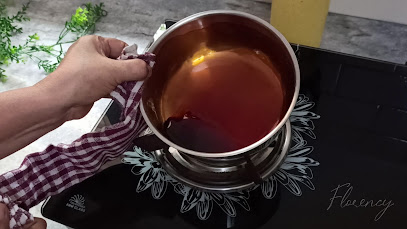Caramel Made Simple | Technique and Science
Caramelization can be tricky but the results are worth the effort. This is a step-by-step instruction guide on making caramel syrup for desserts— the one I use for my Crème Caramel (also called caramel custard, pudding or flan; click for blog post or video). The ‘how’ and ‘why’ are explained to help you understand your food better.
Ingredients:
- 8 tablespoons sugar
- 1 tablespoon water
Method:
- Combine the sugar and the water in a mould (capable of being directly heated) or a saucepan on a medium flame. This is a 'wet' caramel but with minimal water.
Water helps as a medium to
distribute heat evenly preventing the sugar from burning in patches which could
more easily occur in ‘dry’ caramelization.
2. In
the initial stages (about a minute and a half), leave the sugar undisturbed. Only
make sure that the sugar is evenly spread in the pan and pay attention to
observe any change in colour.


3. When it starts to brown in some areas, give the dish (mould or saucepan) a shake or a swirl. This will need to be done frequently to avoid burning the sugar.

4. Avoid using a spoon/spatula to stir this. Any instrumentation and impurity could lead to re-crystallization of the sugar turning it grainy rather than into a syrup.
(At a molecular level, a chain
reaction, like a domino effect, occurs when undissolved grains of sugar from a
spoon/spatula are reintroduced into a pot of melting sugar, creating a lumpy mass. This physical process is referred to as [re]crystallization.)
As sweet as sugar is, it is also dangerously hot when it starts to melt; we advise caution as you cook.
5. Allow
the caramel to acquire a deep golden brown (or deep amber) and then turn of the
heat. This could take around 6 minutes for the quantity mentioned.
6. Swirl
the syrup in the mould to coat its walls evenly. If you are using a saucepan,
pour the caramel into the mould soon after you turn off the heat.
7. Set
it aside to cool and harden.
In the video, we’ve prepared the caramel in a 6-inch stainless steel mould. On turning off the heat, we had additional working time owing to the mould still being hot. However, if it is to be poured from a saucepan into a mould, the cooler temperature of the latter will cause the caramel to thicken faster; a quick hand will be necessary to coat the mould base/bases.
You can also use this as a flavouring/colouring agent or as a classy garnish on desserts. Happy Alchemy!










Amazing recipe
ReplyDeleteThrilled that you found it so! Thank you :)
Delete